
Pathology is the study of the causes and effects of disease or injury. The word pathology also refers to the study of disease in general, incorporating a wide range of biology research fields and medical practices. However, when used in the context of modern medical treatment, the term is often used in a narrower fashion to refer to processes and tests which fall within the contemporary medical field of "general pathology", an area which includes a number of distinct but inter-related medical specialties that diagnose disease, mostly through analysis of tissue, cell, and body fluid samples. Idiomatically, "a pathology" may also refer to the predicted or actual progression of particular diseases, and the affix pathy is sometimes used to indicate a state of disease in cases of both physical ailment and psychological conditions. A physician practicing pathology is called a pathologist.

Rudolf Ludwig Carl Virchow was a German physician, anthropologist, pathologist, prehistorian, biologist, writer, editor, and politician. He is known as "the father of modern pathology" and as the founder of social medicine, and to his colleagues, the "Pope of medicine".
Pathophysiology – a convergence of pathology with physiology – is the study of the disordered physiological processes that cause, result from, or are otherwise associated with a disease or injury. Pathology is the medical discipline that describes conditions typically observed during a disease state, whereas physiology is the biological discipline that describes processes or mechanisms operating within an organism. Pathology describes the abnormal or undesired condition, whereas pathophysiology seeks to explain the functional changes that are occurring within an individual due to a disease or pathologic state.

Thomas Huckle Weller was an American virologist. He, John Franklin Enders and Frederick Chapman Robbins were awarded a Nobel Prize in Physiology or Medicine in 1954 for showing how to cultivate poliomyelitis viruses in a test tube, using a combination of human embryonic skin and muscle tissue.

Sir Archibald Edward Garrod was an English physician who pioneered the field of inborn errors of metabolism. He also discovered alkaptonuria, understanding its inheritance. He served as Regius Professor of Medicine at the University of Oxford from 1920 to 1927.
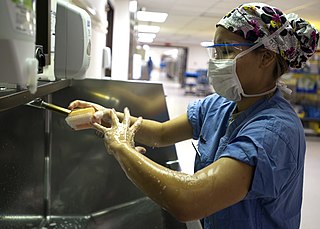
Asepsis is the state of being free from disease-causing micro-organisms. There are two categories of asepsis: medical and surgical. The modern day notion of asepsis is derived from the older antiseptic techniques, a shift initiated by different individuals in the 19th century who introduced practices such as the sterilizing of surgical tools and the wearing of surgical gloves during operations. The goal of asepsis is to eliminate infection, not to achieve sterility. Ideally, a surgical field is sterile, meaning it is free of all biological contaminants, not just those that can cause disease, putrefaction, or fermentation. Even in an aseptic state, a condition of sterile inflammation may develop. The term often refers to those practices used to promote or induce asepsis in an operative field of surgery or medicine to prevent infection.

Dame Honor Bridget Fell, DBE, FRS was a British scientist and zoologist. Her contributions to science included the development of experimental methods in organ culture, tissue culture, and cell biology.
Gerald Domingue is an American medical researcher and academic who served as Professor of Urology, Microbiology and Immunology in the Tulane University School of Medicine and Graduate School for thirty years and also as Director of Research in Urology. He is currently retired and resides in Zurich, Switzerland, where he is engaged in painting and creative writing. At retirement he was honored with the title of Professor Emeritus at Tulane (1967–1997). Prior to Tulane, he served on the faculty of St. Louis University ; was a lecturer at Washington University and director of clinical microbiology in St. Louis City Hospital, St. Louis, Missouri.
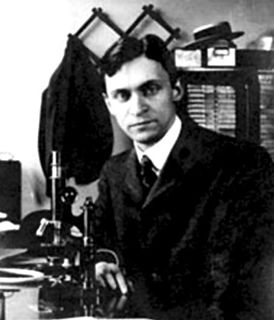
Eugene Lindsay Opie was an American physician and pathologist who conducted research on the causes, transmission, and diagnosis of tuberculosis and on immunization against the disease. He served as professor of pathology at several U.S. medical schools and as Dean of the Washington University School of Medicine.

Frank Burr Mallory was an American pathologist at the Boston City Hospital and Professor of Pathology at Harvard Medical School, after whom the Mallory body is named.
Professor Derek McMinn is a British orthopaedic surgeon and inventor who practises in Birmingham, United Kingdom at the BMI Edgbaston Hospital. Prof. McMinn developed the first successful modern metal-on-metal hip resurfacing and the instrumentation and surgical technique to implant it. Hip resurfacing is a bone-conserving, less invasive alternative to total hip replacement (THR) for young patients, markedly improves the health-related quality of life measures and currently makes up around a tenth of all hip arthroplasty procedures performed in the United Kingdom. McMinn is also the inventor of several other prostheses for the hip and knee.
Louis Blanchard Wilson was an American pathologist and the chief of pathology at Mayo Clinic from 1905 to 1937. Wilson is most famous for initiating the routine use of the frozen section procedure for rapid intraoperative diagnosis.

Henry Roy Dean, MD, LL.D, D.Sc, FRCP, also known as Prof. H. R. Dean, was a professor of Pathology at the University of Cambridge and Master of Trinity Hall, Cambridge.
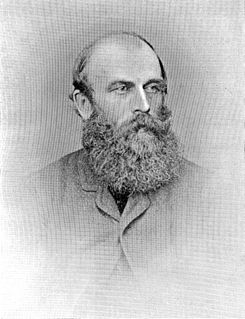
Strangeways Research Laboratory is a research institution in Cambridge, United Kingdom. It was founded by Thomas Strangeways in 1905 as the Cambridge Research Hospital and acquired its current name in 1928. Organised as an independent charity, it was historically funded primarily by the Medical Research Council and is currently managed by the University of Cambridge, also its sole trustee. Formerly a site of research on rheumatic arthritis and connective tissue disorders, it has since 1997 focused on the study of genetic epidemiology.
Frederick Gordon Spear was a British physician and researcher. Originally trained in tropical medicine, he spent time working in what was then the Belgian Congo. After his return to England in 1923, he became interested in radiology and radiobiology. As a member of the Medical Research Council, he was involved in the decision to continue work at Strangeways Research Laboratory following the 1926 death of founder Thomas Strangeways. He served as Deputy Director under the laboratory's longtime director Honor Fell from 1931 to 1958. While at Strangeways he conducted experiments on the effects of radiation on cells and tissues, particularly tissue cultures derived from cancers. He was known for forceful rhetoric in support of the then-controversial field of tissue culture and its potential in informing clinical practice.
John T. Dingle is a British biologist and rheumatologist. He joined the staff of the Strangeways Research Laboratory in 1959 as a research assistant to then-director Honor Fell, and later himself served as director from 1979 to 1993, taking over the position after the death of Michael Abercrombie. His presence at Strangeways helped to move its research direction toward the original research interests of its founder, Thomas Strangeways, who sought to understand the physiology of arthritis and other rheumatic diseases, after many years in which the laboratory specialized more narrowly in tissue culture and cell biology. Dingle was the president of Hughes Hall from 1993 to 1998, and is an honorary fellow. He was the founding chairman of the British Connective Tissue Society, serving from 1980 to 1987. From 1975 to 1982 he was Chairman of the Editorial Board of the Biochemical Journal. Among his notable trainees is University of California, San Francisco cell biologist Zena Werb, who was a postdoctoral fellow with Dingle and subsequently worked as a research assistant at Strangeways.
Rosemary Peyton Biggs was an English haematologist. She worked closely with Robert Gwyn Macfarlane at the Radcliffe Infirmary and Churchill Hospital in Oxford, where she studied coagulation disorders, particularly haemophilia.
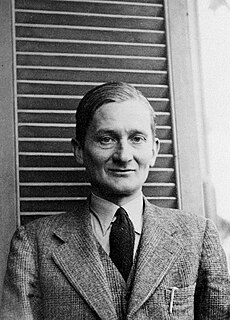
Leslie John Witts (1898–1982) was a British physician and pioneering haematologist.
Eric John Holborow (1918–2009) was a British physician, rheumatologist, and immunologist, known for his pioneering research on autoimmunity.
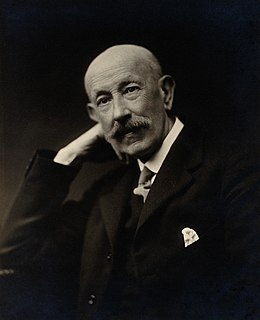
Sir Frederick William Andrewes was an English physician, pathologist, and bacteriologist.













